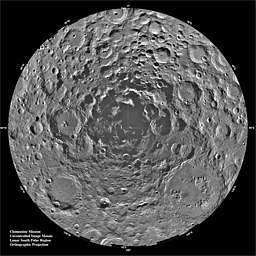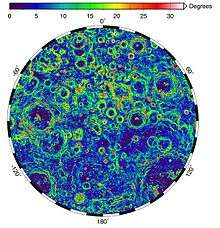Lunar south pole

The lunar south pole is of special interest to scientists because of the occurrence of water ice in permanently shadowed areas around it. Of the lunar poles, the south pole is of greater interest because the area that remains in shadow is much larger than that at the north pole.[1] The lunar south pole craters are unique in that sunlight does not reach the bottom. Such craters are cold traps that contain a fossil record of the early solar system.[2]
Geography
The lunar south pole is located on the center base of the far side of the moon (80°S to 90°S)[3] and covers a distance of about 1250 km.[4] The lunar south pole has shifted 5 degrees from where it previously was billions of years ago. This shift has changed the rotational axis of the moon allowing sunlight to reach areas of the moon previously shadowed. The axis spin is 88.5 degrees from the plane of the elliptic. The south pole contains areas of permanent darkness, where the sunlight never reaches. On the contrary, the pole also contains areas with permanent exposure to sunlight. The south pole contains many craters and basins such as the South Pole-Aitken basin; which appears to be one of the most fundamental features of the moon.[5] The south pole contains mountains such as Epsilon Peak which is taller than any mountain found on earth.[4] The south pole is thermally benign, ranging at an average of 250–270 kelvins.[5]
Craters

The rotational axis of the Moon lies within Shackleton Crater. Notable craters nearest to the lunar south pole include De Gerlache, Sverdrup, Shoemaker, Faustini, Haworth, Nobile and Cabeus.
Exploration

Spacecraft from several countries have explored the region around the lunar south pole. Extensive studies were conducted by the Lunar Orbiter, Clementine, Lunar Prospector, Lunar Reconnaissance Orbiter, Kaguya, and Chandrayaan. NASA's LCROSS mission found a significant amount of water in Cabeus.[6] NASA’s LCROSS mission deliberately crashed into the floor of Cabeus and from samples found that it contained nearly 5% water.[7]
The Lunar Reconnaissance Orbiter, or LRO, is a mission that has already begun and is currently mapping the lunar south pole. This mission will help scientists see if the Lunar south pole has enough sustainable resources to have a permanent station.The LRO had a Diviner Lunar Radiometer Experiment, commonly known as Diviner, on board which investigated the radiation and thermophysical properties of the south pole surface. The Diviner is designed to watch the thermal environment of the south pole. It can detect reflected solar radiation and internal infrared emissions. The LRO Diviner was able to detect where water and ice could be trapped on the surface.[8]
The lunar south pole is suitable for a lunar outpost. The permanently shadowed places on the moon could contain ice and other minerals, which would be vital resources for future explorers. The mountain peaks near the pole are illuminated for large periods of time and could be used to provide solar energy to an outpost. With an outpost on the moon scientists will be able to analyze fossil and water samples dating back to the beginning of the Solar System.[3] One place scientists deemed as an ideal spot for future landing missions. Connecting Ridge is the ridge that connects Shackleton to the de Gerlache crater.[9] Scientists used LOLA (Lunar Orbiter Laser Altimeter) which was a device used by NASA to provide an accurate topographic model of the moon.[10] With this data locations on the south pole were found that yielded sunlight for 92.27% – 95.65% of the time based on altitude ranging from 2m above ground to 10m above ground. At the same spots it was discovered that the longest continuous periods of darkness were only 3 to 5 days.[9]
The Lunar South pole is a place where scientists may be able to use radio waves under 30 Hz. No place in space has been able to use radio waves of this frequency because the waves would interfere with Earth’s radio signals. The lunar south pole has mountains and basins that are not facing earth and would be an ideal place to project radio signals.[11]
Future
India's second lunar mission, Chandrayaan-2, scheduled to launch on April 2018 will attempt to soft-land a lander and rover in the south polar region of the moon. If successful, Chandrayaan-2 will be the first ever mission to land a rover on the moon's unexplored south pole. [12]
Future planned exploration of the Lunar south polar region includes a private mission by Shackleton Energy Company, no earlier than 2016. Shackleton intends to land a robotic precursor exploration rover to "identify and characterize the nature, composition and locations of the optimum ice concentrations at the north and Lunar south pole craters".[13]
Lunar Mission One[14] is a British-led, unmanned Moon mission announced in November 2014 and planned for 2024.[15] It will attempt to land on the lunar south pole, then drill down at least 20m and possibly as deep as 100m. This could dramatically improve the understanding of the Moon's composition, its geologic history and formation, revealing new clues about the early Solar System. The mission is attempting to gain crowdfunding on Kickstarter.[16]
Blue Origin is planning a mission to the south polar region in about 2020. This would lead to a series of missions landing equipment for a colony in a south polar region crater, using their Blue Moon lander.[17][18]
Discoveries
Illumination
The lunar south pole is one of the only spots in space that Illumination Conditions from the sun exist. These conditions at the Lunar South Pole have been observed using High Resolution Digital Terrain Models from LOLA.[9] In addition to its illumination conditions, its surface can also reflect solar wind as energetic neutral atoms. On average, 16% of these atoms have been protons that varies based on location. These atoms have created an integral flux of backscattered hydrogen atoms due to the reflected amount of plasma that exists on the surface of the moon. They also reveal the line boundary and the magnetic dynamics within the regions of these neutral atoms on the moon’s surface.[19]
Cold traps
Cold traps are some of the important places on the lunar south pole in terms of possible water and iced deposits. Cold traps can contain water and ice that were originally from comets, meteorites and solar wind induced iron reduction. From experiments and sample readings scientists were able to confirm that cold traps do contain ice. Hydroxyl has also been found in these cold traps. The discovery of these two compounds has led to the founding of missions focusing primarily on the lunar poles using global scale infrared detection. The ice stays in these traps only because of the thermal behavior of the moon. These thermal behaviors are controlled by thermophysical properties, scattered sunlight, thermal re-radiation, internal heat and light given off by the earth. With the cold temperatures in the cold traps delivering ice could be a possibility in the near future, since it would not melt.[8]

Magnetic surface
In addition to the amount of cold traps discovered, there also exists areas of the moon where the crust is magnetized. This is what is known as the magnetic anomaly that exists on the surface of the moon due to the remnants of metal iron that was emplaced by the SPA basin-forming impactor. The observations of the moon’s surface were conducted using iron perspected maps to locate the concentration of iron that is embedded in the moon’s surface. However, the concentration of iron that was theorized to be in the basin was not present in the mappings, but other plausible ideas were still possible to detect this amount of iron. With regards to the SPA Impactor,the iron causing the magnetic fluctuations could still be present, but were not detected as they could be too deep in the moon’s crust for the mappings to detect or caused by another anomaly that did not involve metallic properties. In addition, the findings were proven inadequate due to the inconsistencies between the maps that were used and they were not able to detect the magnitude of the magnetic fluctuations that occurred from the moon’s surface.[20]
See also
References
- ↑ "South Pole Region of the Moon as Seen by Clementine". NASA. June 3, 1996. Retrieved March 4, 2010.
- ↑ "NASA Takes Aim at Moon with Double Sledgehammer". Space.com. February 27, 2008. Retrieved March 4, 2010.
- 1 2 [NASA – Lunar South Pole. (2017). Nasa.gov. Retrieved 29 March 2017, from https://www.nasa.gov/mission_pages/LRO/multimedia/lroimages/lroc-20100927_southpole.html]
- 1 2 [Lunar South Pole. (2017). Fossweb.com. Retrieved 29 March 2017, from https://www.fossweb.com/delegate/ssi-wdf-ucm-webContent/Contribution%20Folders/FOSS/multimedia/Planetary_Science/binders/moon/moon_images/lunar_south_pole_1.html]
- 1 2 Spudis, P. D.; Stockstill, K. R.; Ockels, W. J.; Kruijff, M. (1995). "Physical Environment of the Lunar South Pole from Clementine Data: Implications for Future Exploration of the Moon". Abstracts of the Lunar and Planetary Science Conference. 26. Bibcode:1995LPI....26.1339S.
- ↑ Chang, Kenneth (November 13, 2009). "LCROSS Mission Finds Water on Moon, NASA Scientists Say". The New York Times. Retrieved March 4, 2010.
- ↑ [(2017). Retrieved 29 March 2017, from https://lunar.gsfc.nasa.gov/lessonkit/Diviner-Planning%20a%20Mission%20to%20South%20Pole.pdf]
- 1 2 Wei, Guangfei; Li, Xiongyao; Wang, Shijie (2016). "Thermal behavior of regolith at cold traps on the moon׳s south pole: Revealed by Chang׳E-2 microwave radiometer data". Planetary and Space Science. 122: 101. Bibcode:2016P&SS..122..101W. doi:10.1016/j.pss.2016.01.013.
- 1 2 3 Gläser, P.; Scholten, F.; De Rosa, D.; Marco Figuera, R.; Oberst, J.; Mazarico, E.; Neumann, G.A.; Robinson, M.S. (2014). "Illumination conditions at the lunar south pole using high resolution Digital Terrain Models from LOLA". Icarus. 243: 78. Bibcode:2014Icar..243...78G. doi:10.1016/j.icarus.2014.08.013.
- ↑ [NASA – LOLA. (2017). Nasa.gov. Retrieved 29 March 2017, from https://lola.gsfc.nasa.gov/]
- ↑ Takahashi, Yuki D. (2003). "A concept for a simple radio observatory at the lunar south pole". Advances in Space Research. 31 (11): 2473. Bibcode:2003AdSpR..31.2473T. doi:10.1016/S0273-1177(03)00540-4.
- ↑ Pallava Bagla (31 Jan 2018). "India plans tricky and unprecedented landing near moon's south pole". sciencemag.org.
- ↑ Shackleton Energy's cislunar economic development plans Archived 2013-01-05 at the Wayback Machine. David Livingston interview with James Keravala, The Space Show, 14 Dec 2012, at 55:25–57:40, accessed 2012-12-22.
- ↑ Lunar Mission One, http://www.lunarmissionone.com
- ↑ "UK 'to lead moon landing' funded by public contributions". BBC. 19 November 2014. Retrieved 19 November 2014.
- ↑ "LUNAR MISSION ONE: A new lunar mission for everyone". Kickstarter. 19 November 2014. Retrieved 19 November 2014.
- ↑ Monica Hunter-Hart (7 April 2017). "Blue Origin is Still Going to the Moon, Even if Mars is Hip". inVerse.
- ↑ Christian Davenport (2 March 2017). "An exclusive look at Jeff Bezos's plan to set up Amazon-like delivery for 'future human settlement' of the moon". Washington Post.
- ↑ [Vorburger, A. (2015). Imaging the South Pole–Aitken basin in backscattered neutral hydrogen atoms. Planetary And Space Science, 115, 57–63.]
- ↑ Cahill, Joshua T.S.; Hagerty, Justin J.; Lawrence, David J.; Klima, Rachel L.; Blewett, David T. (2014). "Surveying the South Pole-Aitken basin magnetic anomaly for remnant impactor metallic iron". Icarus. 243: 27. Bibcode:2014Icar..243...27C. doi:10.1016/j.icarus.2014.08.035.
